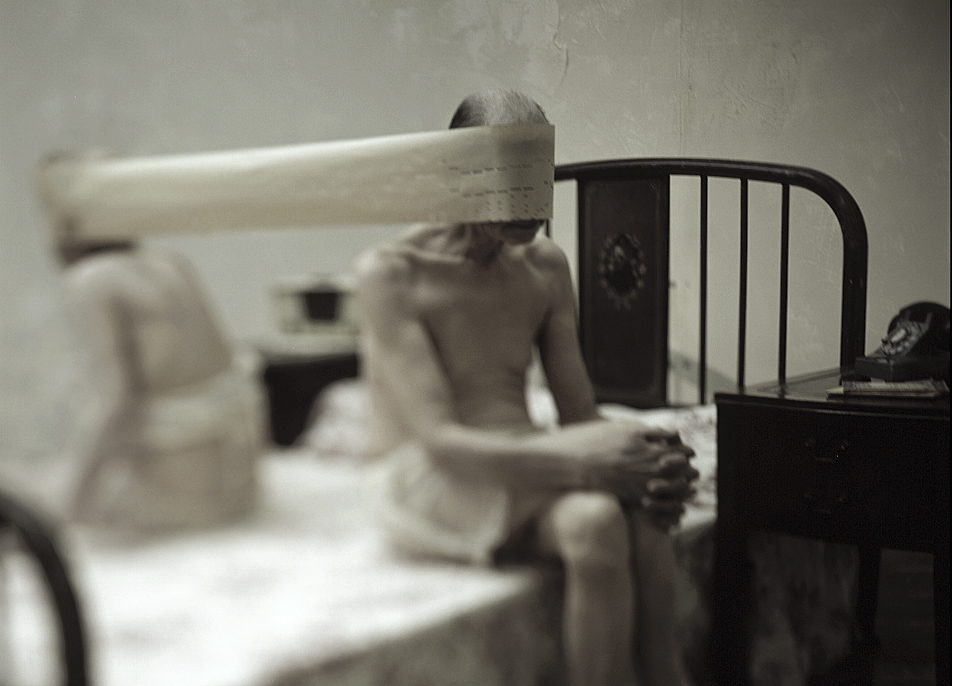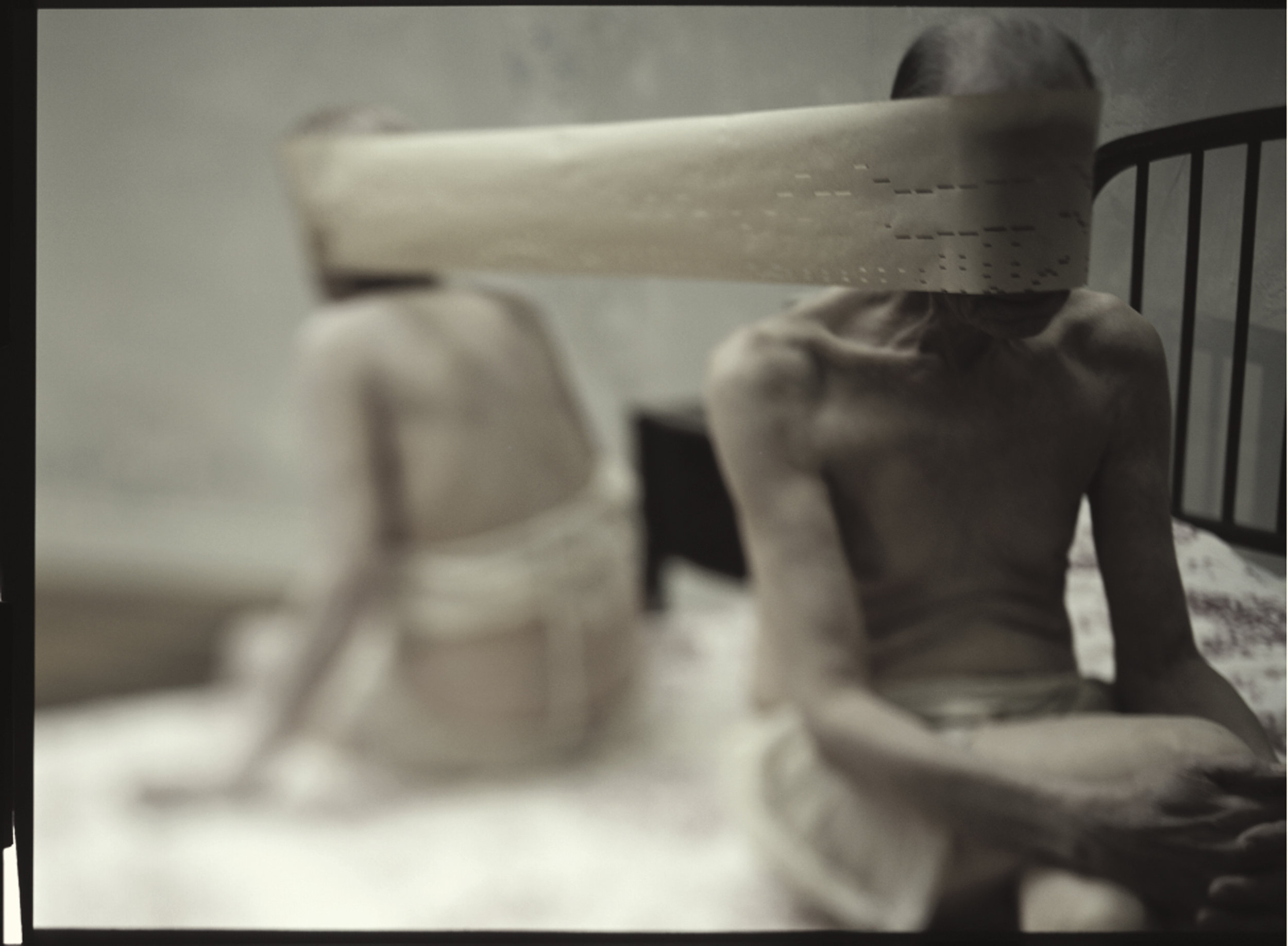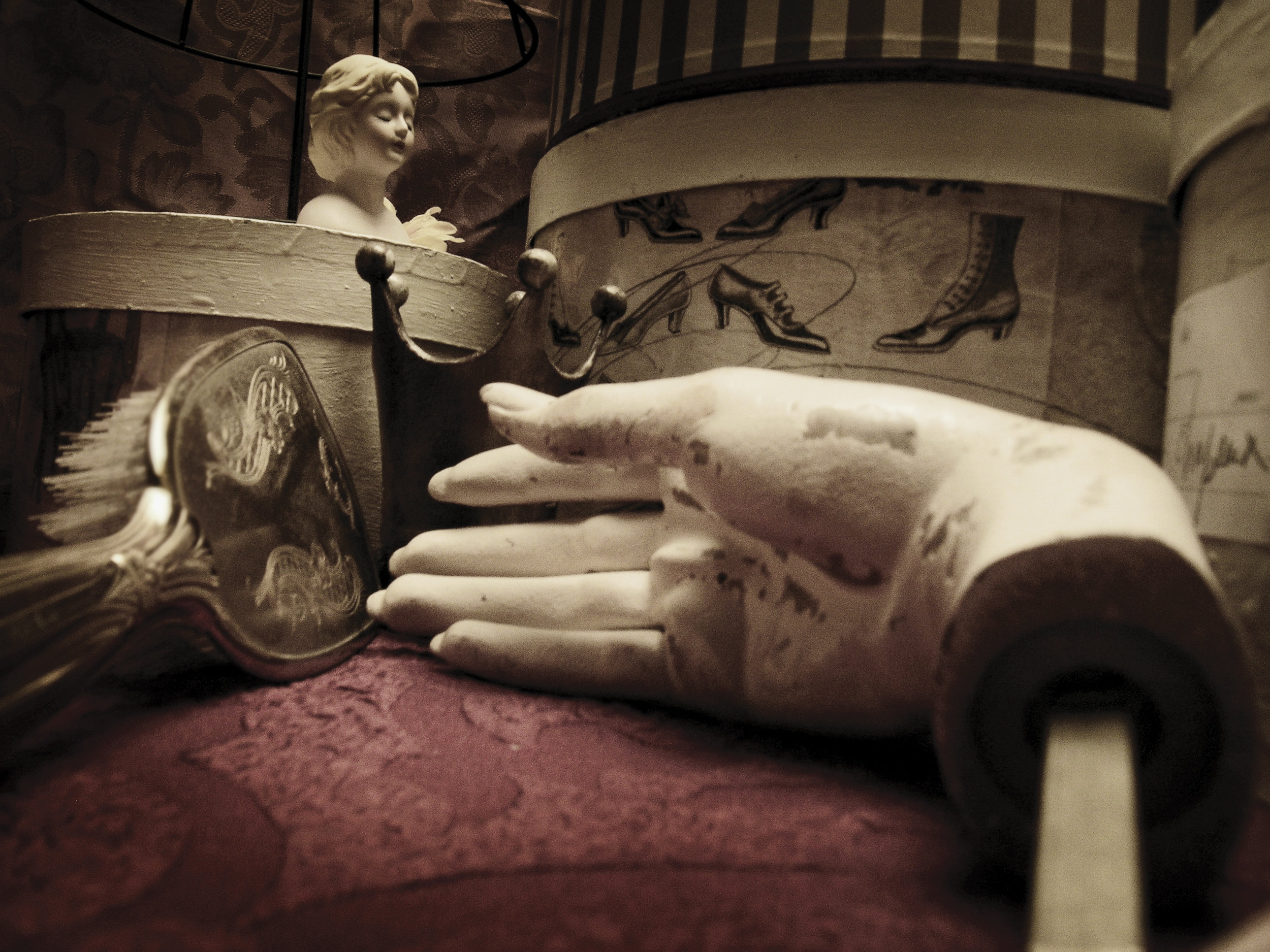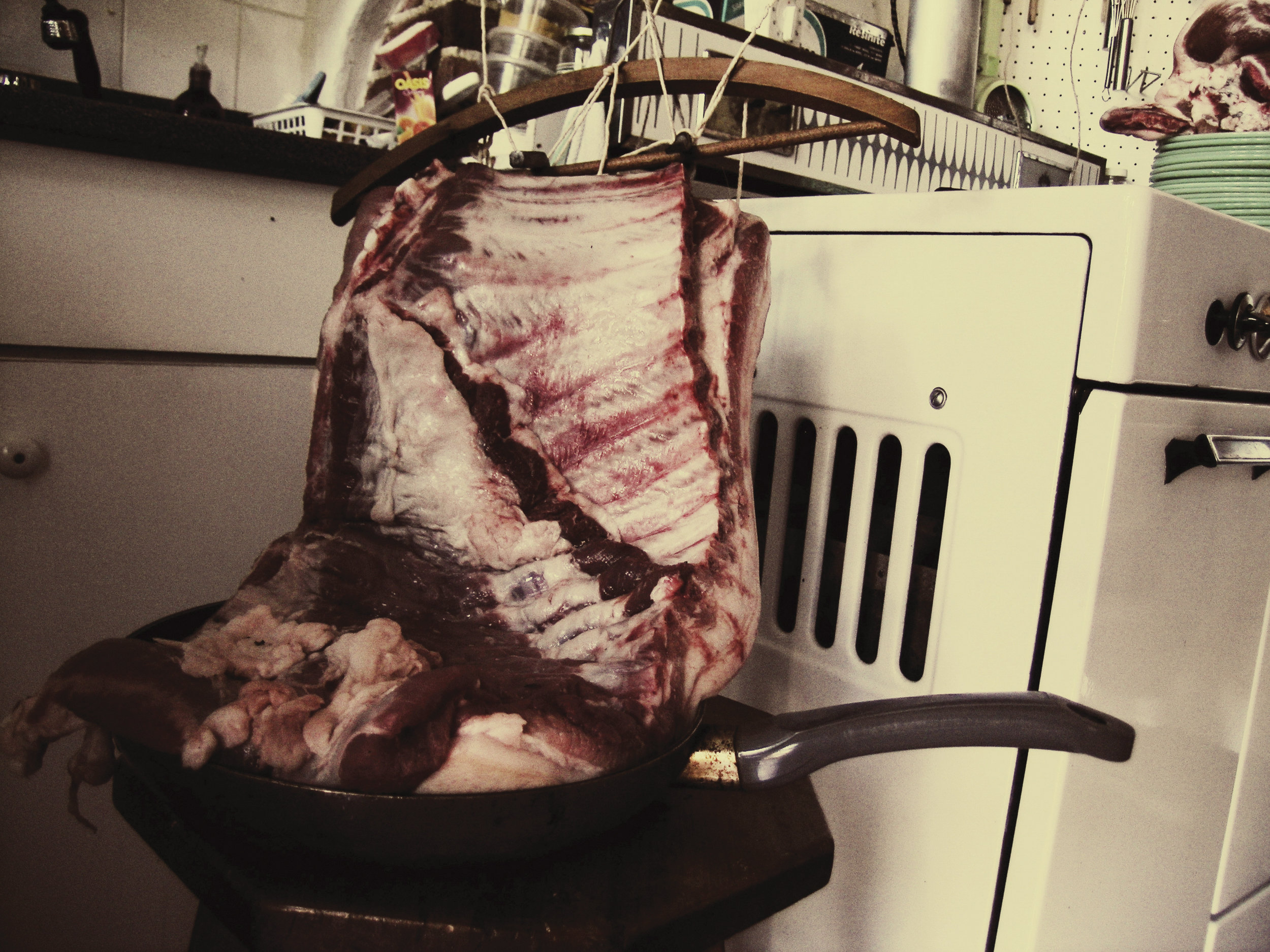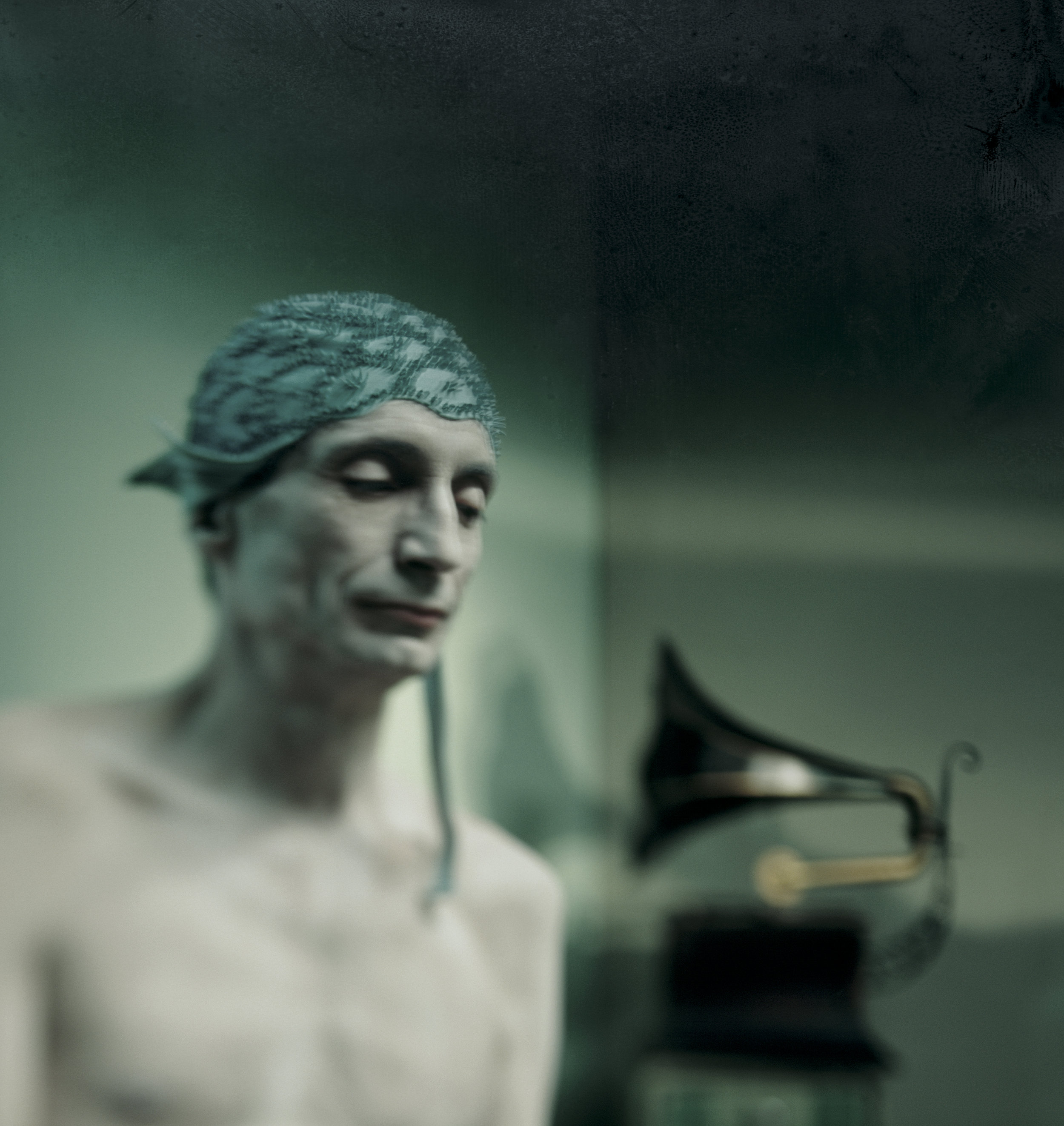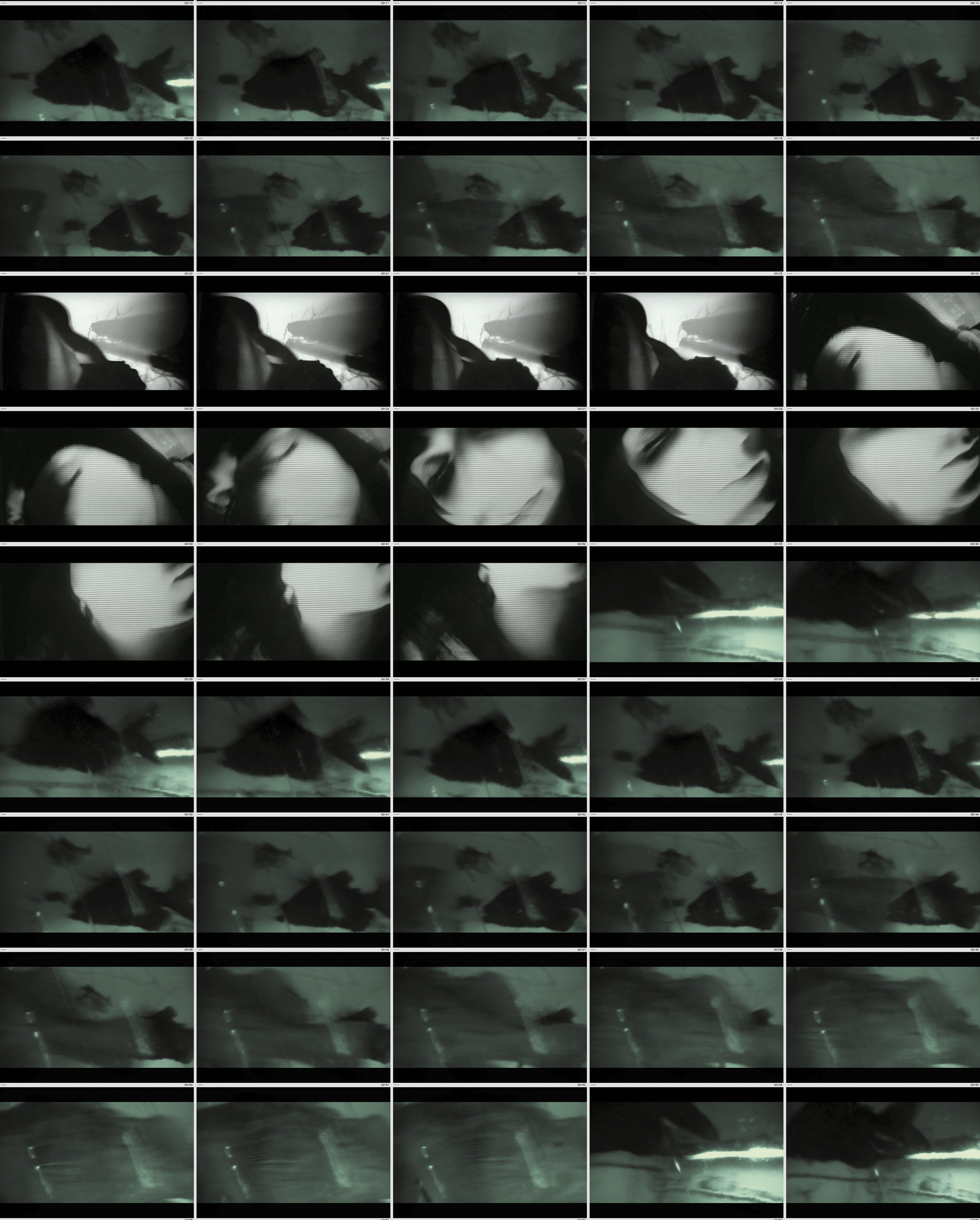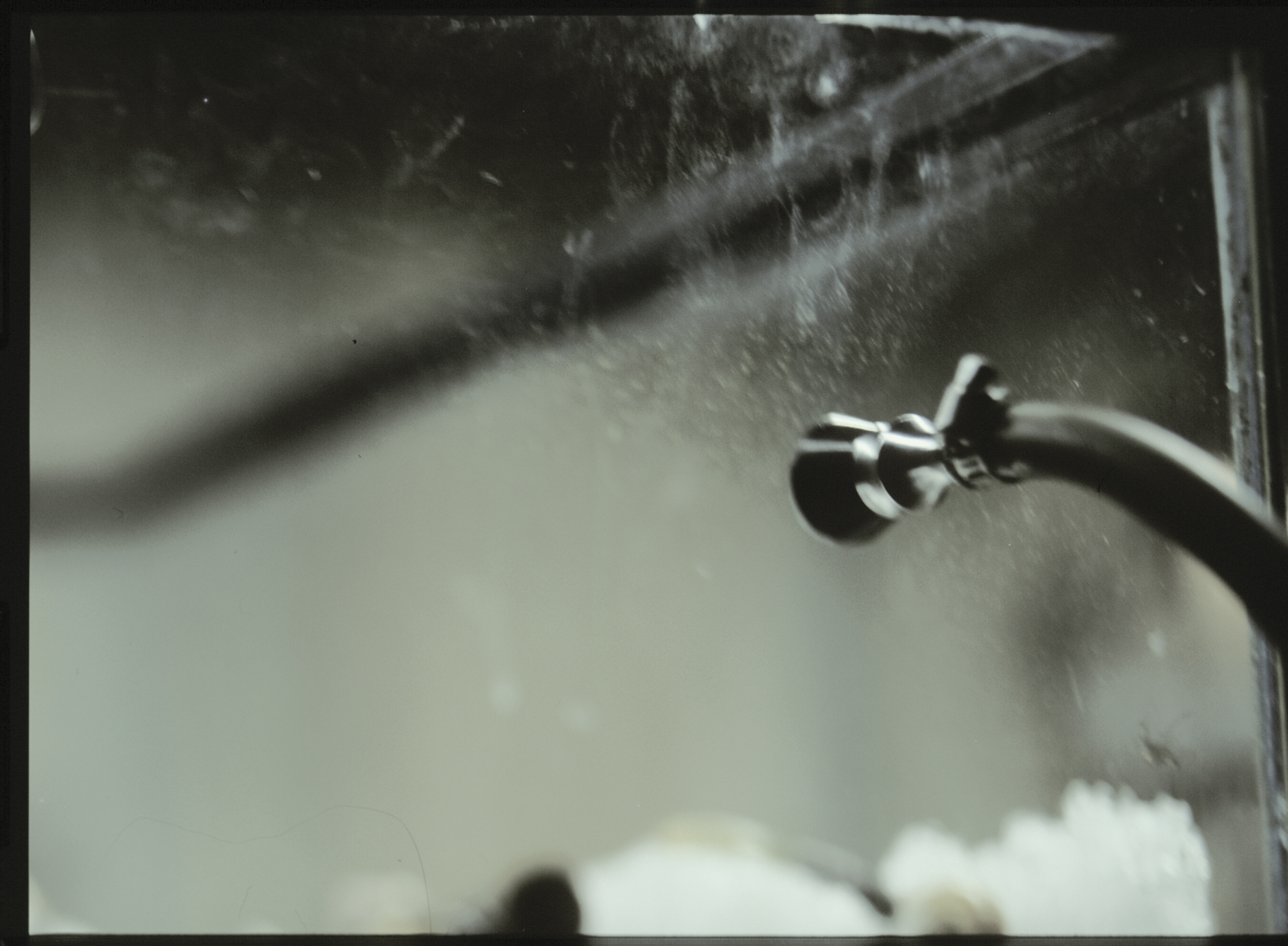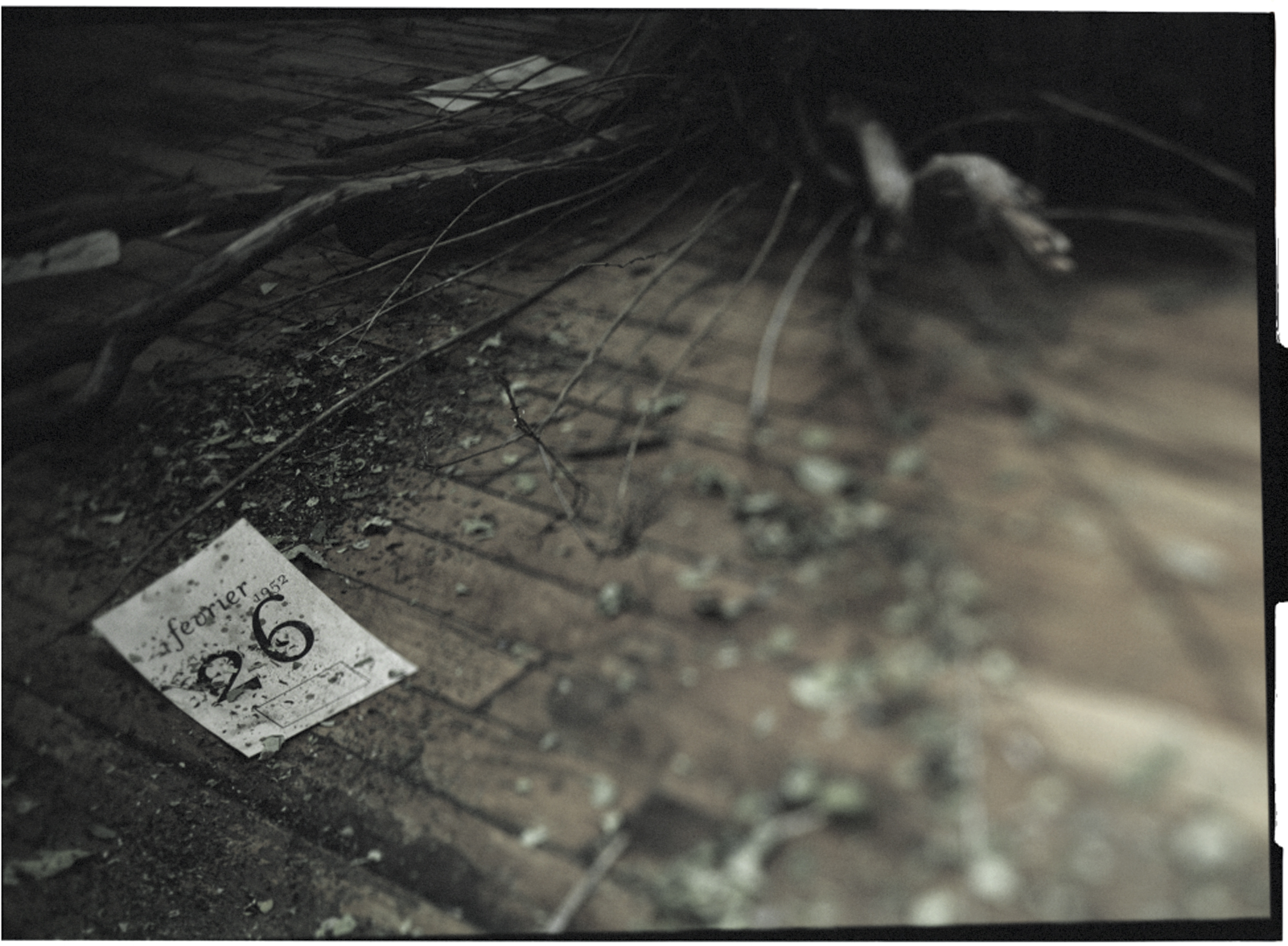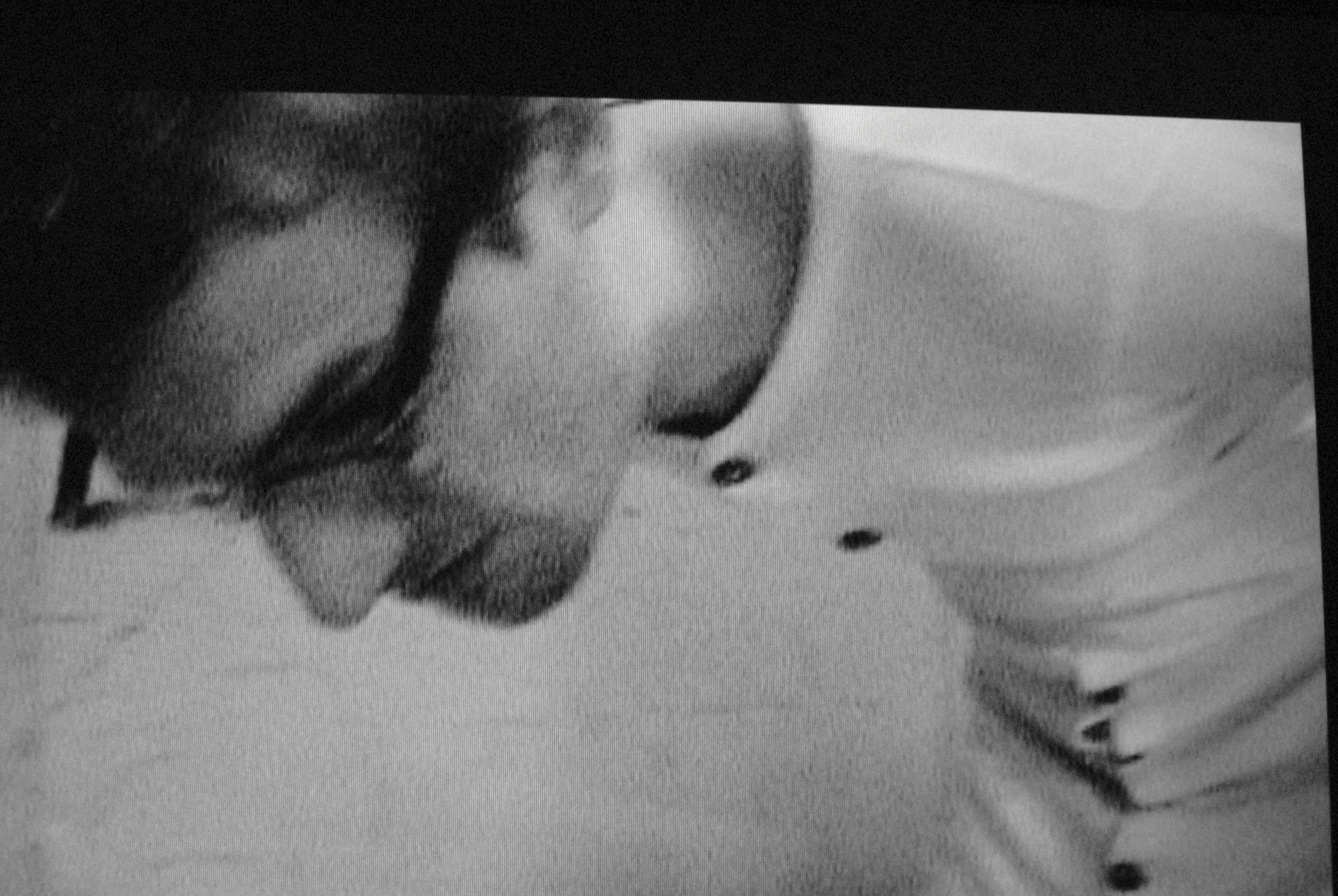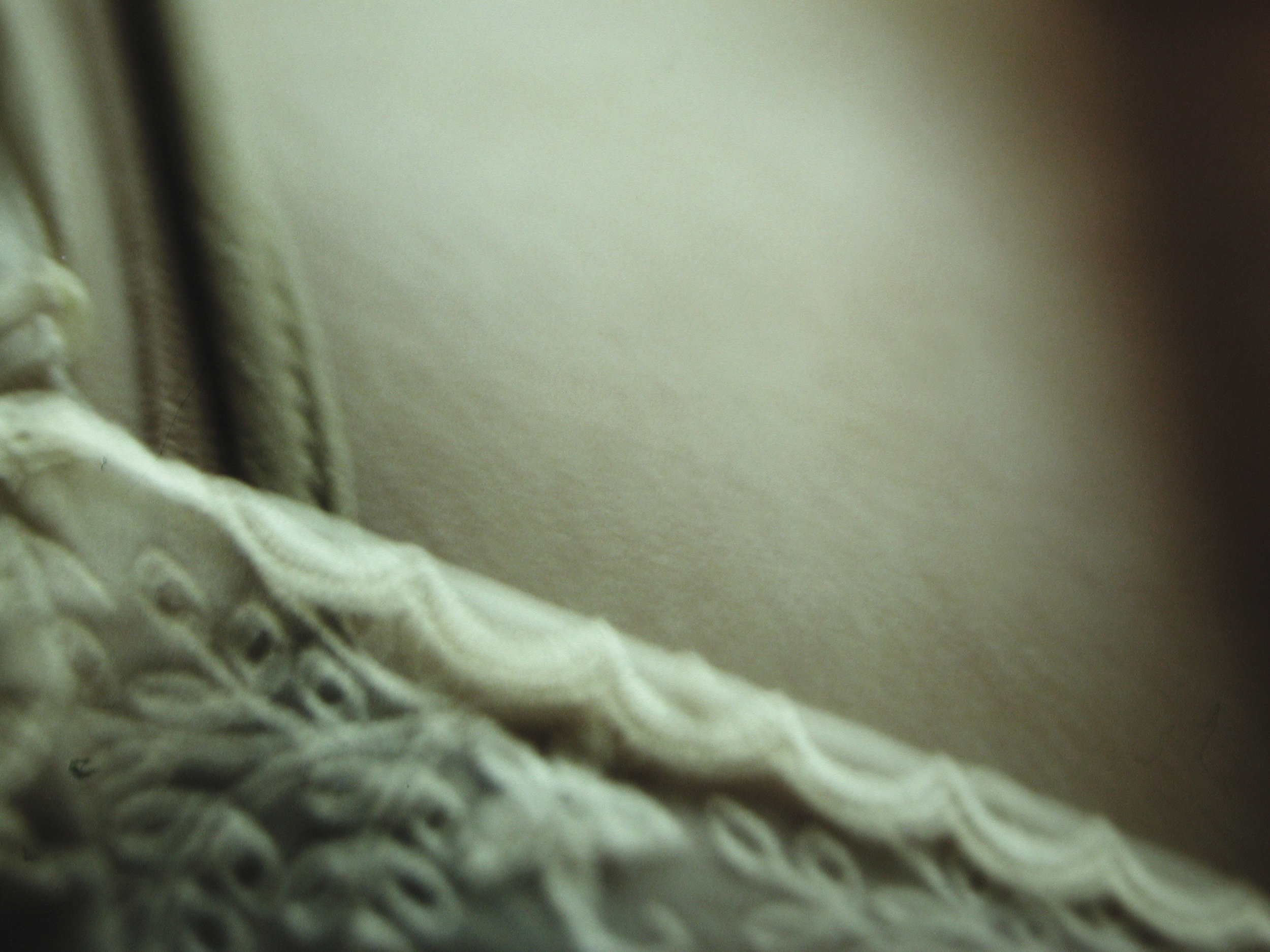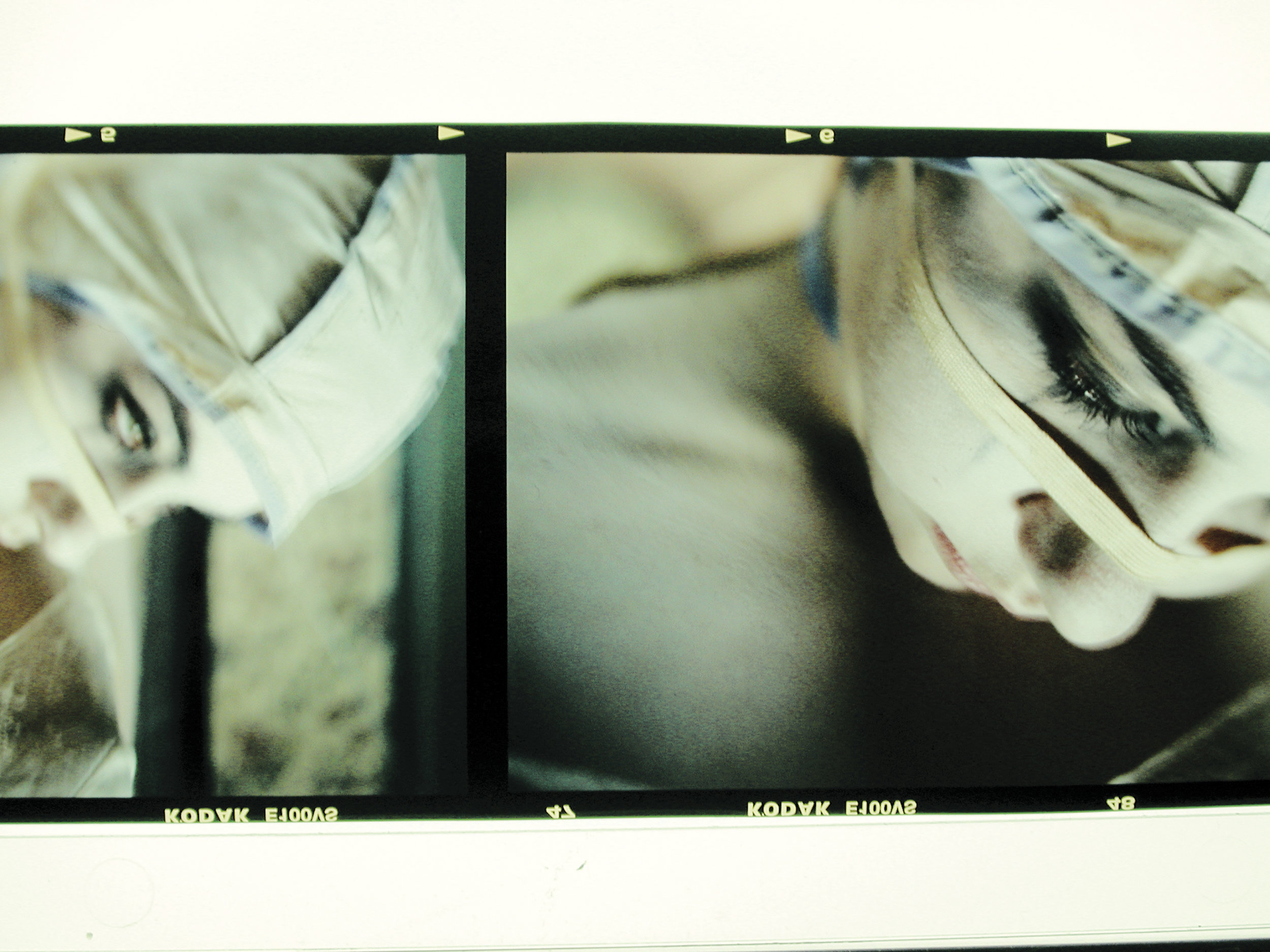Silent room
film-poème en seize tableaux par Skoltz_Kolgen, 2003. Qwartz Awards 5 / Best Video, Paris, France. 2009 / Best Experimental Film - Feature Film, New York Independant Film and Video Festival, New York, États-Unis. 2004
Par Les Yeux,festival Du Cinéma Différent, Palais Des Beaux-Arts, Lille, France | Riam #5, Rencontres Internationales des Arts Multimédia, Marseille, France | Le Cube, Issy Les Moulineaux, France | Spot Taipei Film House,Taipei, Taiwan | The Imprint Of Sound, Taoyen + Kaohsiung, Taiwan | Festival Nemo - Panorama Selection, Paris, France | Sonar In Korea - Sonarfiles, Korea | Festival X, Videopulsiones. Tecnologias Do Sentimento, Lisbone, Portugal | Kultür Buro Barcelona, Barcelone, Espagne | Mutek Mx - Sala De Arte Publico Siqueiros, Mexico DF, Mexique | Bergen International Film Festival, Bergen, Norvège | Dissonanze, Rome, Italie | Lo Sguardo Di Ulisse, Naples, Italie | Cinéma de l’Office National du Film, Montréal, Canada | Lausanne Underground Film & Video Festival, Lausanne, Suisse | Send & Receive, Winnipeg, Canada | Villette Numérique, Grande Halle De La Villette, Paris, France | Festival du Nouveau Cinéma de Montréal / Présentation Spéciale, Montréal, Canada.
Silent room synopsis
Vue en coupe de seize individus, de seize chambres, de seize intimités, Silent Room se présente comme la radiographie de seize intériorités. Ici, la chambre est à proprement parler l’intérieur. Un intérieur en discontinuité, où s’opèrent, suivant une logique de contamination des sens, des échanges insolites et poétiques. Ce film-poème ne propose donc pas une histoire, mais un ensemble de tableaux vivants s’organisant chacun autour d’une idée fixe, d’une impulsion, d’un vide, d’une soif d’idéal. Silent Room, est un cinéma de clair-obscur, un cinéma de chambre, où ce qu’il y a de plus silencieux et de moins visible vient violemment murmurer sa présence. Dans leur travail, les artistes Skoltz_Kolgen ont adopté une approche “fotocinétique” fondée sur la fragmentation temporelle de l’action. Ils ont utilisé, pour ce faire, plusieurs techniques de captation en simultané,confrontant de cette manière les différents points de vue. Afin d’obtenir un contrôle encore plus précis sur le temps, ils ont conçu une série de caméras séquentielles synchronisées par ordinateur. Sept mille photographies ont donc été digitalisées et animées. Par la suite, ils ont développé une interface numérique reliant de façon précise la dynamique de la bande audio à l’image. À l’aide de cette technologie, ils ont réussi à créer une intime synergie entre le son et les personnages. Et c’est cette proximité qui sert en quelque sorte de trame narrative au film. La musique et la sonorisation expriment ainsi l’état d’être des lieux et la réalité intérieure des personnages. Aucun dialogue ne vient préciser ou rassurer. On est plutôt ici sous hypnose contrôlée.
Silent Room est un objet inclassable, intense et ancré dans son temps.
Silent room synopsis (english)
A cross-sected view of 16 people, 16 rooms, 16 private lives, Silent Room is an x-ray vision of 16 interiors. In this film-poem, the room is felt from the inside. An interior steeped in discontinuity, where unusual and poetic communications unfold wordlessly, through a contamination of the senses. Rather than a story line, there is a set of tableaux vivants, each crafted around a fixed idea, an impulse, a void, a hunger for an ideal. Silent Room is a cinema of light and shadow, a chamber cinema, wherein the most silent and least visible elements violently descend to murmur its presence. In their work, the skoltz_kolgen artists use a fotocinetique approach founded on the temporal fragmentation of action. To achieve this effect, several simultaneous captation techniques were used, in confrontations of various vantage points. For a more precise control of time, a battery of cameras were sequentially synchronized to take over 7,000 photographs, which were subsequently digitized and animated. The skoltz_kolgen cell then developed digital frequency-sensitive image- generating software that instantaneously shadows the audio track — somewhat like a heartbeat monitor that shadows the frequencies of a heartbeat, but in this case each frequency of sound can generate its image equivalent. Playing with interludes of this split-second synergy between sound and film, the music and scoring express a state of affect within the rooms and the internal reality of the characters. This is the film’s narrative track. There is no dialogue to foster understanding or any reassurances for the viewer. Instead, we remain in a state of controlled hypnosis.
Silent Room is an art object that defies classification — a highly potent film of its time.
“On silent room
by Lucinda Catchlove
“My painting is visible images which conceal nothing; they evoke mystery and, indeed, when one sees one of my pictures, one asks oneself this simple question, ‘What does that mean? It does not mean anything, because mystery means nothing either, it is unknowable.” – René Magritte
Ceci n’est pas un film…
Silent Room is not a film. Though Silent Room can be presented as a feature-length film in the physical and conceptual context of a conventional movie theatre, film is merely one of many mediums and conventions engaged. Silent Room tentatively sits – fidgeting and shifting – within the white box that contains video art and photography. But Skoltz_Kolgen are wont to sully and poke holes in pristine white boxes…to gum up the works and subvert sanctioned sites of surveillance…to illuminate the treachery of images. Originally imagined as an installation, Silent Room is as much a work of sound art as of visual art. It is a work that requires time, that broaches at least four dimensions in its attempt to unwind an infinity of potentials - not as strings of theory but as strands of experience. Silent Room proposes a plurality of subjective dimensions that are themselves private, interior and ephemeral, by engaging the imagination and existential resources of the viewer. The DVD presentation of Silent Room similarly intends to break the linear temporality and passive receptivity of traditional film and video representation and linear narrative. While the DVD offers the option to view Silent Room as a linear feature film, the artists’ hope is that you will return to visit with characters individually and find the time and space within yourself to allow these characters to visit with you. The CDs offer complimentary meditations upon private chambers – be they interior or exterior – through investigations by commissioned artists and Skoltz_Kolgen’s own play upon the concept of chamber music.
“The shadow cast by a four-dimensional figure on our space is a three-dimensional shadow . . . by analogy with the method by which architects depict the plan of each story of a house, a four-dimensional figure can be represented (in each one of its stories) by three-dimensional sections. These different sections will be bound to one another by the fourth dimension.”
– Marcel Duchamp
Inside The Silent Room: Psyche and The Secret Life of Butterflies
It is important to know that Skoltz_Kolgen originally conceived Silent Room as an installation because it reveals the artists’ intent to place the audience within the work – to engage us as participants not merely observers. We are asked to interact, to become attached and implicit, and to enter into the Silent Room rather than observe from a safe, detached distance. We are asked to pass through the doors of perception and over the threshold of the unconscious into another world that is extemporaneously intertwined with materiality. These journeys through interior landscapes, where borders between the ephemeral and actual are blurred, carry us across the river of consensual reality and into the underworld where Psyche’s monsters slumber and ego’s fallen angels take flight. There is no exquisite corpse to dissect with disembodied intellect because the heart and soul demand visceral understanding that can be gained only through experience. Without empathy, there can be no art. Without empathy there can be only illustrated theory, a cold accrual of ideas that deny the irrationality of the senses and the subjectivity of emotions and, ultimately, of life itself. We enter the Silent Room through empathy, through the visceral corporeality of emotions, through the portal of our own body.
Les Champs Magnétiques
Silent Room is poetry in motion; it engages time, space and dimensionality beyond the current conventions of film (though well within the context of Luis Bunuel’s hopes for a Surrealist cinema that deploys the full potential of film as an artistic medium). Composed of sensual and sensorial experiences, the work bypasses the intellectuality of words and the constricting banality of narrative to draw aim at the heart of the matter. It proposes a place where the doors of perception are unhinged from objectivity, where meaning is subjective and open to projection, where each viewer’s illuminating consciousness and shadowy unconscious inflect upon the imagery they absorb from the flickering light and shadow of the screen. It proposes a contemporary poetry that is visceral and instinctive…embodied. A place where mind overcomes matter in a revolution of the unconscious, where matter becomes mythical, and silence is broken and fractured into a million splinters of perception. Filled with static and hiss, with compulsions and obsessions, with the rhytms of neurosis and the accidental melodies of the soul, Silent Room exposes the subjective symphonies that exist beneath social silence. It illuminates and liberates the shameful secrets, hidden joys, subversive desires, quixotic hopes, and rituals of disorderly meaning that silently unfold behind closed doors.
Drawing Inspiration
The characters that take shape in Silent Room first emerged through a series of informal sketches that spilled from the artists’ waking consciousness onto paper during the ritual of their morning coffee. Started in 2000, and drawn over the space of a year, these random sketches inspired a curiosity in the artists about the interior life of strangers, about who someone is when alone behind closed doors away from the constraints of social observation. A desire to see these characters in motion, to see them animated and embodied, inspired the artists to capture them on film.
Skoltz_Kolgen began to envision an installation that physically created and emotionally evoked these fictional characters’ interior spaces. They imagined a room for each character within an old apartment building, or a similarly appropriate context that extended the worlds and aesthetic of Silent Room into a fragmented but cohesive physical space. Within each room there would be a film illuminating a character’s interior landscape (projected onto a wall or shown on a television); objects, textures and smells related to the character; and an immersive sonic environment. But rather than being hermetic environments, these spaces were intended to bleed sound and scent, to overlap and impinge, to take us into the interior life of a character while also making us conscious of the world outside of each room. Just as the viewer would impinge upon each character’s hermetic isolation, so too would our own sense of hermetic separation be impinged upon when we entered into the private space of a character’s room. It is within this context of communal isolation, this series of non-hermetic and immersive environments, that we find Silent Room.
Creative Process: Constructing Room for Silence
Skoltz_Kolgen started sketching and fleshing out characters, and gently nursing the seeds that would become Silent Room, at their kitchen table in 2000. But the couple’s commercial work consumed most of their days, and the germinal seeds saw only a little sunlight. Then the dramatic events of September 11th, 2001 blew our world, and each of our personal worlds, suddenly asunder. Dominique Skoltz and Herman Kolgen responded by dedicating themselves passionately to the pursuit of meaningful creative projects. One of which was the ambitious, soon to be all consuming, Silent Room.
Selecting 22 characters from the larger collection of sketches they’d accumulated, the artists approached each character with an open, organic methodology that included further sketching, developing sonic portraits and characteristic sounds, and accruing symbolic objects (both found and constructed). The characters, the scenarios they inhabit, and even the process itself, remained in a constant state of flux and evolution during the entirety of the creative process. From conception through the filming, editing, and assembling of the project, Silent Room has always remained open to alteration, accident and influence. The plasticity of digital video and sound has allowed Skoltz_Kolgen to approach the process of composing their audiovisual work in a fluid manner that they liken to painting, and this organic and experimental quality extends into future performance, screen and installation versions of Silent Room.
Factory
At the end of 2001, Skoltz_Kolgen transformed an old textile warehouse into a makeshift film studio for a month. The artists constructed and tore down sets on a daily basis, sometimes filming two scenarios in a day. They filmed over 22 segments, and many of the visual effects and optical distortions were created on set and then filmed. Each character had specific actions and scenarios prescribed, and each shoot started with filming these planned sequences. To convey the rhythm and emotional tonality of a scenario, and to synchronize a character’s movements with the sonic sensibility that Skoltz_Kolgen had already painted, the sound portraits were played during filming. Skoltz_Kolgen also filmed interpretations and improvisations upon the characters that the people playing them generously offered from their own imaginations. In some instances, a character’s action proved to be physically impossible to realize or would be less effective than imagined so Skoltz_Kolgen would be called to improvise new scenarios. All these elements of chance and accident further liberated the characters from the page, lending these beings wings that lifted them beyond the artists’ desires.
Screen Tests
Dominique Skoltz and Herman Kolgen shot all the footage themselves with handheld digital video cameras. This allowed them to improvise, change perspectives and to capture images and moments intuitively. They also customized midi software to trigger 6 35MM cameras, and used static surveillance cameras to captured additional digital video footage. This variety of cameras allowed multiple simultaneous perspectives, a variety of image textures and some unusual effects. In addition, still photographs were taken with a 120MM camera. Skoltz_Kolgen created a density and diversity of visual material. Ultimately, over 10, 000 photographs were taking during the creation of Silent Room, and months of video footage shot. The artists concentrated on capturing their imagination as it unfolded before their lenses, on noticing the beautiful accidents that occurred, and accepting the generous interpretations of the collaborators that inhabited the beings as they made their way onto film.
Outer and Inner Space
In January 2003, Skoltz_Kolgen began treating the raw materials they’d created during the shoot and they would continue to refine and edit all aspects of the project for the following 18 months. The ability to constantly rework and re-edit digital video imagery allowed the artists a great deal of flexibility and the capacity to manipulate sound and image in a way that would not be possible with traditional film and editing techniques. They created an interface that allowed them to synchronize sound and image, and the editing and post-production process engaged both film editing and animation techniques. The thousands of photographs taken using the synchronized cameras were manually scanned and digitized one by one before being reassembled to create stop motion animations. Each scenario was worked and reworked as its own entity, and Dominique and Herman would work on each character alone before handing it to the other to continue to work upon. Each character became a corpse exquisite that danced between the two artists. Any results that both could not agree upon were discarded, and the character was approached anew. In June and July of 2002, Skoltz_Kolgen filmed additional footage in Prague for four characters before returning to Montreal and resuming the process of shaping the sounds and images which expressed these beings that had begun as casual sketches over morning coffee.
Clockwork
In 2003, while still in the editing process, Skoltz_Kolgen were invited to screen Silent Room as a film at the Montreal International Festival of New Cinema and New Media (FCMM). Up until this point they had been working towards creating audiovisual works that functioned as abstract portraits, cinematic poems, or even as synaesthetic songs. These compositions were to be individual but not hermetic, existing within the larger context of an installation. The intention was for the characters to be gathered under one roof and for sound to leak between rooms. Presenting the characters in the format of a feature-length film automatically inferred a linear narrative rather than the simultaneous abstractions of the installation where beginnings and endings were blurred and inconsequential. Skoltz_Kolgen began the process of considering and editing the individual scenarios into a linear form. Additionally, the inevitable time constraints that come with presenting Silent Room in a linear form – rather than as simultaneously occurring events - eventually led the artists to choose 16 characters to present in 11 scenarios that were greatly reduced from their installation form. In some instances the artists folded more than one character into a scenario. Skoltz_Kolgen re-edited the film between screenings at the FCMM and continue to this day to add brushstrokes to this tableau vivant. Ultimately, Silent Room remains open to re-interpretation, recontextualization and further experimentation by the artists. Not only can the content vary between screenings, but the work is also effected by the liberating or constraining context within which it is presented. The version presented on this DVD contains scenarios for three additional characters that were not presented in the versions screened previous to its release.
Sound & Vision
Skoltz_Kolgen experimented simultaneously with the sounds and images associated with each character. The audio sketches of the characters evolved alongside the drawings, and these basic audio portraits were used during the shoots to inform the people embodying the characters of that character’s rhythmic and tonal personality. Skoltz_Kolgen also developed an interface that allowed them to manipulate and edit sound and image simultaneously resulting in an audiovisual work that borders on synaesthesia where sound and vision often overlap, displacing and contaminating each other. Frequently it’s the sound that defines the action, serving as the impetus rather than the consequence or byproduct of action. The sound compositions don’t merely serve as soundtracks that support the visual action; the sound becomes an agent of action itself propelling compulsive tics and emotional urges that exist powerfully beyond the constraints of intellectual intent. The sounds of Silent Room tap into the preverbal and bypass sight’s symbolic language; they are provocative rather than evocative, prescriptive rather than descriptive.
Which is not to deny the extensive thought, theory and affection for the work of other artists that informs the creation of all of Skoltz_Kolgen’s work. The compositions are constructed using a variety of sources and materials including field recordings, instruments such as cello and piano, and digitally created sounds and manipulations. In many ways, Silent Room is essentially as much a visual song as a cinematographic poem. Often the editing techniques and aesthetic memes adopted in Silent Room - the rewinds, stuttering samples, changes of tempo, and percussive rhythms – more strongly reflect conventions of contemporary digital music making than that of film. However, materially and aesthetically, Silent Room also has roots as deeply embedded in classical and avant garde experimentation as in any popular culture trope.
Ultimately, what distinguishes Silent Room as an audiovisual work rather than a “film” in the common sense is that the sound and images of Silent Room never exist in isolation. Even during the editing process, sound and image were interwoven causing the conventions and aesthetics of one to contaminate the other. The existential and metaphysical space of the Silent Room expands and contracts upon a fluid architecture of sound creating an environment where silence speaks volumes.
////////////////////////
On silent room
by Lucinda Catchlove
adaptation française > Sophie Massé
« Ma peinture est faite d’images qui ne camouflent rien ; elles évoquent le mystère et ainsi, quand quelqu’un voit une de mes toiles, il peut se poser cette simple question “ Qu’est-ce que ça veut dire ? “ Ça ne veut rien dire, parce que le mystère ne veut rien dire non plus, il est impénétrable. » – René Magritte
Ceci n’est pas un film…
Silent Room est un film qui n’est pas un film. On peut le projeter comme un long-métrage, dans le contexte physique conventionnel d’un cinéma, c’est vrai, mais le cinéma n’est pour lui qu’un médium parmi d’autres. Silent Room se tient en équilibre incertain sur la cloison entre vidéo d’art et photo. Mais puisque pour Skoltz_Kolgen le vrai travail est de démanteler les structures, cette cloison trop lisse sera salie, profanée et trouée: ces brèches se feront postes d’observation. Entrera aussi par là le jour qu’il faut pour mettre en lumière la duplicité des images. Conçue à l’origine comme une installation, Silent Room est une oeuvre tant sonore que visuelle qui prend son temps et le temps de celui qui la regarde; dans sa tentative de se livrer un peu à la fois, comme le font chacun des pans d’une expérience, elle juxtapose au moins quatre dimensions. Par-dessus tout, elle résiste à toute définition théorique. Silent Room présente des strates subjectives plurielles, intimes et éphémères, qui s’enracinent dans l’imagination et les pulsions du spectateur. De la même manière, la version DVD de Silent Room cherche à briser la chronologie narrative d’un visionnement cinéma ou vidéo traditionnel. Alors que le DVD permet de visionner Silent Room de façon linéaire, comme un long-métrage classique, le voeu secret des artistes est que les allées et venues des spectateurs entre chacune des chambres aillent au gré de l’intérêt et du caprice de chacun, et que cette curiosité tire l’observateur par la manche dans l’univers du personnage qui aura capté son attention d’abord. Peut-être ce personnage
continuera-t-il à l’habiter bien après leur rencontre.
« L’ombre que projette une figure en quatre dimensions est en fait une ombre à trois dimensions, si l’on se fie à la méthode avec laquelle les architectes représentent le plan de chacun des étages d’une maison ; une figure en quatre dimensions peut être représentée (à chacun des ses étages) par des sections en trois dimensions. Ces différentes sections sont liées les unes aux autres par la quatrième dimension. » – Marcel Duchamp
Au coeur de Silent Room : Psyché et la vie secrète des papillons
Il est important de savoir que Skoltz_Kolgen ont d’abord imaginé Silent Room comme une installation ; cela traduit leur intention de placer le spectateur dans l’enclos de l’oeuvre, d’impliquer le public comme participant et pas seulement comme observateur. On lui demande d’interagir, de se commettre ; on l’invite de façon implicite à entrer dans la chambre, à passer le pas de la porte, à abolir toute forme de détachement. On lui propose de franchir la barrière de ses perceptions, de passer le seuil de l’inconscient pour atteindre un autre monde, momentanément enchevêtré au monde matériel. Ces périples à travers les paysages intérieurs, où les frontières entre l’éphémère et le ponctuel s’estompent, nous transportent sur l’autre rive de la réalité consensuelle et à la lisière des limbes, où les cerbères de Psyché sommeillent et les anges déchus de l’ego s’évanouissent dans l’air. Il n’y a pas ici, pour le scalpel qu’est l’intellect, de cadavres exquis à disséquer ; le coeur et l’âme aspirent à une compréhension viscérale, qui ne s’obtient que par l’expérience. Sans empathie, il ne peut y avoir d’art. Sans empathie, on reste figé devant une théorie illustrée, un inventaire méthodique d’idées qui réfutent l’irrationalité des sens, la subjectivité des émotions et, ultimement, la vie elle-même. On entre dans Silent Room à travers l’empathie, par le corps tangible et viscéral des émotions, par le portail qu’est notre propre corps.
Les Champs Magnétiques
Silent Room est un poème en mouvement; il sollicite le temps, la spatialité et la perspective au-delà des conventions filmiques habituelles. En ce sens, il fait écho au souhait de Luis Bunuel qui rêvait d’un cinéma surréaliste capable d’extraire tout le potentiel artistique du film comme médium artistique. Composée d’expériences sensuelles, sensorielles, l’oeuvre court-circuite la rationalité des mots et la banalité contraignante de la narration pour aboutir au coeur des choses. Elle propose un espace où l’objectivité se détraque, où la signification est assujettie à la projection, au transfert, à la translation. Un lieu où la conscience du spectateur illumine les ombres de son inconscient à mesure que les images défilent à l’écran, vacillant entre le clair et l’obscur. C’est un poème contemporain, intime et instinctif. Incarné. Un séjour là où l’esprit l’emporte sur la matière dans une riposte de l’inconscient. Un espace, enfin, où la matière devient chimérique et où le silence éclate en un million de fragments perceptuels. Pétri de statique et de crissements, obsessif et compulsif, Silent Room transcrit le rythme de la névrose et des ratés mélodiques de l’âme. Il monte le volume de ce que la collectivité souhaite taire. Il libère au grand jour les fantômes honteux du secret, de la joie refoulée, des désirs subversifs, des souhaits quichottiens, des rituels désordonnés, qui ont droit de cité seulement derrière les portes closes.
Les desseins de l’inspiration
Les personnages profilés dans Silent Room se sont d’abord manifestés – à partir de 2000 – par des esquisses qui ont débordé sur la feuille depuis la conscience fraîchement éveillée des artistes pendant leur rituel du café matinal. Échelonnés sur une période d’un an, ces dessins aléatoires ont déclenché chez eux une grande curiosité quant à la vie intérieure de ces inconnus. S’est alors manifestée une sorte d’envie d’indiscrétion, la tentation de partir à la rencontre de ces gens alors qu’ils sont dans l’intimité de leur maison, à l’écart de l’étiquette, et que personne ne peut les voir. C’est le désir de les épier qui a inspiré les artistes à leur donner corps et vie sur pellicule.
Skoltz_Kolgen ont échafaudé une installation capable de reproduire dans l’espace le monde intérieur de ces personnages fictifs pour lui donner une résonance émotive. Dans un vieil immeuble à appartements – un lieu qui permet de prolonger l’esthétique des différents univers dans un tout fragmenté, mais cohérent – ils ont réservé une pièce à chacun des personnages. La vie intérieure de ceux-ci allait être mise en lumière par un film, projeté sur un mur ou diffusé dans une télé. Cette pièce, sanctuaire d’objets, de textures et d’odeurs amarrés au personnage, était aussi un lieu d’immersion sonore. Ces espaces était conçus pour distiller autant le son que les odeurs, pour se chevaucher, pour que l’on puisse s’initier à la vie intérieure, intime des personnages sans faire abstraction de ce qui se passe à l’extérieur de chaque pièce. Alors que le visiteur commence à infiltrer l’isolation où baigne chacun des personnages, son propre sentiment d’être hermétiquement séparé du reste se dissout dans l’espace privé de la chambre. C’est dans ce contexte d’isolation collective, dans cette suite d’environnements immersifs illusoirement étanches, que l’on reconnaît Silent Room.
Le processus créatif : construire un espace pour le silence
En 2000, Skoltz_Kolgen commencent à s’attarder à un projet inspiré de sa collection de personnages imaginaires, maintenant étalés sur un nombre grandissant de croquis furtifs. Comme leur désir de voir ces personnages s’imposer avait mûri, les artistes ont commencé à discuter des meilleures façons de les présenter dans une installation. Et puis, le 11 septembre 2001, une sorte d’épiphanie leur est venue sous forme d’urgence ; que resterait-il à accomplir s’ils n’étaient plus là demain ? C’est à ce point de bascule qu’il se sont engagés à donner vie à ces personnages.
Ils en ont choisi vingt-deux. Ils ont abordé le projet avec une approche ouverte, instinctive et organique. Il leur fallait d’abord des esquisses plus fouillées, mais aussi des portraits sonores distinctifs, et une accumulation d’objets symboliques – à la fois trouvés tels quels et construits de toutes pièces – pour forger la trame intime de chacun des personnages. Cette trame est restée mouvante et évolutive pour l’ensemble du processus de création, qui a obéi à un mouvement de flux et reflux continuel. La conception du projet, par périodes alternées de tournage, montage et assemblage, à laissé la part belle aux accidents, aux altérations et à diverses influences. La malléabilité de la vidéo et du son numériques a permis à Skoltz_Kolgen de composer leur oeuvre comme une toile, où les couches de peinture se recouvrent les unes des autres dans une sorte de palimpseste mouvant.
La fabrique _Factory
À la fin de 2001, Skoltz_Kolgen improvisent un studio de cinéma dans une ancienne manufacture textile. Pendant un mois, parfois à coup de deux scénarios par jour, les artistes ont construit et déconstruit les décors sur une base quotidienne. Ils ont filmé plus de vingt-deux segments. La plupart des effets visuels et des distorsions optiques sont crées sur le plateau, puis filmées. Chaque personnage obéit à des actions et à un scénario précis, et chaque tournage commence par ces séquences préétablies. Pour traduire le rythme et la tonalité émotive d’un scénario, et pour synchroniser les mouvements des personnages et le portrait sonore que Skoltz_Kolgen avaient déjà dépeint, ces tableaux sonores sont joués pendant les prises. Skoltz_Kolgen filment aussi les variations et les improvisations que les interprètes – à partir de leur propre imagination – proposent sans compter. Dans certains cas, les actions prévues s’avèrent physiquement impossibles à réaliser ou moins efficaces que prévu. Skoltz_Kolgen doivent inventer sur place de nouveaux scénarios. Tous ces éléments fortuits, faits d’accidents et de révélations, ont propulsé les personnages très, très loin de la page, pour les faire atterrir dans des territoires bien au-delà des aspirations des artistes.
Screen tests_Arrêts sur image
Dominique Skoltz et Herman Kolgen ont tourné toutes les images eux-mêmes, caméra numérique au poing, ce qui leur a permis d’improviser, de faire volte-face, de pervertir les perspectives, de capter les moments et les images de manière intuitive. En plus de prélever du piétage additionnel à l’aide de caméras de surveillance fixes, ils ont aussi mis à leur main un logiciel midi qu’ils ont synchronisé à six caméras 35mm. Cette variété de caméras les a pourvus de multiples perspectives simultanées, d’une grande disparité de textures visuelles. Par ailleurs, plus de dix mille photos, prises avec une caméra 120mm, se sont ajoutées au matériel issu de plusieurs mois de tournage vidéo. Skoltz_Kolgen ont exigé et obtenu une grande densité et diversité de matériel visuel. Ils se sont appliqués à intercepter leur imagination à mesure qu’elle se pointait devant la caméra. À noter les riches accidents de parcours. À laisser, enfin, leur travail être façonné de la main des interprètes, à mesure que leurs gestes poussaient peu à peu leur personnage à prendre vie sur la pellicule.
Dedans et dehors
Skoltz_Kolgen commencent le tri du matériel brut en janvier 2003. Pendant dix-huit mois, ils vont composer, décomposer, monter, démonter pour mieux remonter. La possibilité de remettre cent fois l’ouvrage sur le métier, propre à la vidéo numérique, donne aux deux créateurs une souplesse de travail jamais égalée par les techniques traditionnelles de montage sonore et visuel. Habitués des logiciels sur mesure, ils créent une interface capable de synchroniser le son et l’image. Cette étape de la postproduction implique à fois un travail de montage et des techniques d’animation. Les milliers de photos prises avec les caméras synchronisées sont numérisées une à une avant d’être assemblées pour créer des animations en image par image. Dominique et Herman travaillent et retravaillent chaque scénario comme une entité autonome. Ils se penchent sur les personnages, en solitaire d’abord, avant de les donner ensuite à l’autre pour qu’il y travaille à son tour. À terme, chaque personnage se présente comme un cadavre exquis qui virevolte entre les deux artistes. Tout résultat qui n’obtient pas la faveur des deux créateurs est écarté et ce personnage est reconstruit de zéro. En juin et juillet 2002, Skoltz_Kolgen ont filmé des images supplémentaires à Prague pour quatre de leurs personnages avant de revenir à Montréal pour mettre la dernière main à l’identité visuelle et sonore de ces êtres nés de croquis indistincts à l’heure du café matinal.
L’horlogerie
En 2003, le Festival international du nouveau cinéma et des nouveaux médias de Montréal (FCMM) invite Skoltz_Kolgen, toujours en processus de montage, à présenter Silent Room dans une version long-métrage. Jusque là, ils avaient conçu leur oeuvre comme une installation, appuyée sur des portraits abstraits, des poèmes cinétiques ou même des airs synesthétiques. L’intention de départ était de faire cohabiter les personnages sous un même toit et de faire circuler leurs univers sonores librement à travers les cloisons. Ces compositions étaient destinées à des vies autonomes, et sans être complètement indépendantes, elles n’obéissaient pas à une structure linéaire. Le film exigeait quant à lui de mettre en scène les personnages dans une narration en continu, et de renoncer momentanément à l’abstraction et à l’ubiquité conférées par l’installation, où le début de chaque séquence s’indifférencie de la fin, dans une suite aléatoire et diachronique. Skoltz_Kolgen commencent donc à considérer chacun des tableaux de manière indépendante pour ensuite les monter les uns à la suite des autres. Par ailleurs, les contraintes de temps – inévitables – ont amené les artistes à choisir seize personnages dans onze scénarios, remaniés pour en faire des abrégés de l’installation. Dans certains cas, les artistes font cohabiter plus d’un personnage dans un même scénario. Skoltz_Kolgen ont même remonté le film entre les projections au FCMM, et continuent encore maintenant d’ajouter des coups de pinceau à ce tableau vivant. Au final, Silent Room reste une oeuvre ouverte. Elle est pétrie de réinterprétations, de recontextualisations et d’explorations toujours approfondies. Elle est aussi influencée par les permissions et les contraintes propres au contexte de projection, qui varie d’un visionnement à l’autre. La version gravée sur ce DVD comprend des scénarios inédits pour trois personnages inconnus jusqu’ici.
Son et vision
Le travail sonore de Silent Room est indissociable de l’image. Pour arriver à un tel entremêlement, Skoltz_Kolgen ont fait des tests simultanés avec les sons et les images associés à chacun des personnages. Les croquis audio ont progressé main dans la main avec les esquisses sur papier, et ces portraits audio sommaires ont été utilisés pendant le tournage pour donner aux interprètes l’instinct, le rythme et le ton de leur personnage. Skoltz_Kolgen ont aussi développé une interface qui leur permet de manipuler et monter le son et l’image simultanément. Cette façon de faire a donné un oeuvre audiovisuelle à la frontière de la synesthésie, où le son et l’image empiètent l’une sur l’autre, se bousculent et se contaminent. Souvent, c’est le son qui définit l’action ; il en est plutôt l’impulsion première que sa conséquence ou son faire-valoir. Les compositions sonores refusent un rôle de trame sonore ou de support à l’action. Le son s’impose comme opérateur de l’action, il orchestre des tics compulsifs et des pulsions émotives qui survivent aux contraintes de la volonté intellectuelle. Les sons de Silent Room jaillissent du préverbal, et contournent les repères symboliques de la vue : ils sont plus provocateurs qu’évocateurs, plus directifs que descriptifs.
C’est à cette signature singulière qu’on reconnaît tout le travail de Skoltz_Kolgen : une réflexion fouillée qui se nourrit d’une importante base théorique et d’une grande admiration pour le travail d’autres artistes. Les compositions sont construites à partir d’une multitude de sources, le matériel brut se compose de sons d’ambiance captés ici et là, d’instruments comme le violoncelle et le piano, de sons synthétiques et de manipulations numériques. Sous plusieurs rapports, Silent Room est autant une musique visuelle qu’un poème cinétique. Les techniques de montage et les sèmes esthétiques qui font Silent Room – les retours en arrière, les cafouillages, les incartades rythmiques et les variations percussives – s’apparentent plus à la musique numérique contemporaine et à l’échantillonnage qu’au cinéma. Cependant, dans sa forme matérielle et esthétique, Silent Room s’enracine autant dans l’expérimentation classique et l’exploration d’avant-garde que dans les avatars de la culture populaire. En bout de ligne, puisque que les sons et les images ne vivent jamais isolément, Silent Room s’impose comme une oeuvre audiovisuelle et c’est ce qui la distingue d’un film. Même pendant le montage, les sons et les images s’emboîtaient les uns aux autres, forçant les conventions et l’esthétique des uns à contaminer les autres. L’espace métaphysique et existentiel de Silent Room se débride et se contraint dans une architecture sonore fluide, créatrice d’un environnement où le silence raconte les volumes.
////////////////////////
On silent room
by Lucinda Catchlove
traduzione italiana > Sabrina Michielli
« La mia pittura è un insieme di immagini visibili che non nascondono nulla; evocano mistero piuttosto, e, infatti, quando qualcuno vede una delle mie fotografie si pone una unica domanda : “Cosa significa?”. Non significa nulla, perchè il mistero in se non significa nulla, ed è inconoscibile. » – René Magritte
Ceci n’est pas un film…
Silent Room non è un film. Anche se Silent Room nella sue veste completa può essere presentato fisicamente e concettualmente all’interno di un cinema convenzionale, il film è solo uno dei mezzi e delle convenzioni usate per realizzare il progetto. Silent Room tenta di porsi, giocoso e mobile, in quel puro contenitore che contiene video arte e fotografia. Skoltz_Kolgen è un collettivo che sembra essere nato però per macchiare e bucare i contenitori, soprattutto se puri ed intatti… il duo ne inceppa i meccanismi e ne sovverte i sistemi di sorveglianza per svelare alla fine quanto traditrice sia l’immagine.Originariamente pensato come una installazione Silent Room è più un lavoro che appartiene all’ambito sonoro che a quello visivo. È un lavoro che richiede tempo, che affronta almeno quattro dimensioni nel suo tentativo di abbracciare infinite potenzialità – non sul piano teorico bensì sul piano dell’esperienza. Silent Room propone una pluralità di dimensioni soggettive che sono allo stesso tempo private, interiori ed effimere, impegnando l’immaginazione e le risorse esistenziali dello spettatore.
La presentazione di un DVD di Silent Room similmente intende corrompere la percezione temporale lineare della rappresentazione e della narrazione tradizionale di film e video. Se il DVD offre l’opzione di vedere una versione lineare del film Silent Room, la speranza degli artisti è che lo spettatore possa ritornare ad indagare i personaggi individualmente, trovando poi il tempo e lo spazio interiore perchè questi personaggi tornino a visitarlo in un’altra dimensione. Il CD offre, invece, in modo complementare l’opportunità di meditare privatamente sulle singole camere – dall’interno o dall’esterno – attraverso le interpretazioni del duo o quelle commissionate direttamente da Skoltz_Kolgen ad altri artisti sul concetto di musica da camera.
“L’ombra prodotta da una figura di quattro dimensioni sul nostro spazio è un’ombra tridimensionale… analogamente al metodo con cui gli architetti disegnano la planimetria delle storie di ogni casa, una figura a quattro dimensioni può essere rappresentata (in ognuna delle sue storie) da una sezione tridimensionale. Queste differenti sezioni sono unite l’una all’altra dalla quarta dimensione.” – Marcel Duchamp
All’interno di Silent Room: la psicologia e il segreto della vita delle farfalle
È importante sapere che originariamente Skoltz_Kolgen aveva concepito Silent Room come una installazione perchè rivela l’intenzione degli artisti di porre al centro del lavoro lo spettatore: chi partecipa non deve essere solo un mero osservatore. Al pubblico è richiesto di interagire, di diventare implicito all’opera come una sorta di suo allegato, di entrare in Silent Room invece che di osservarlo da lontano da una distanza di sicurezza. Allo spettatore è richiesto di oltrepassare le porte della percezione e di varcare la soglia dell’inconscio verso un mondo diverso, solo temporaneamente gemellato con la materialità. Questi viaggi verso paesaggi interiori, dove i confini tra l’effimero e la realtà sfumano l’uno nell’altro, ci fanno navigare sul fiume della realtà consensuale verso quel mondo sotterraneo dove i mostri della psiche dormono beatamente e gli angeli caduti dell’ego prendono il volo. Non c’è un corpo delicato da sezionare con l’intelletto scorporato, perchè il cuore e l’anima domandano solo una comprensione viscerale che può essere raggiunta unicamente attraverso l’esperienza. Senza empatia, non esiste l’arte. Senza empatia può esserci solo teoria illustrata, un freddo insieme di idee che nega l’irrazionalità dei sensi e la soggettività delle emozioni e infine la vita stessa. Penetriamo Silent Room attraverso l’empatia, attraverso la corporeità viscerale delle emozioni, attraverso il portale del nostro stesso corpo.
Les Champs Magnétiques
Silent Room è poesia in moto; richiede del tempo, spazio e una dimensione che va oltre quella convenzionale del cinema (tuttavia si collega con il contesto delle speranze di Luis Buñuel per un cinema surrealista che sfruttasse le piene potenzialità del film come mezzo artistico). Composto di esperienze sensuali e sensoriali, l’opera aggira l’intellettualità delle parole e la banalità limitante della narrazione e mira al cuore della materia. Propone un luogo dove le porte della percezione sono staccate dall’oggettività, dove il significato è soggettivo e si apre alla proiezione, dove la coscienza illuminante di ogni spettatore e l’ombroso inconscio si ripiegano sulle immagini che assorbono dalla luce tremolante e dalle ombre dello schermo. Propone una poesia contemporanea che è viscerale e incorporata istintivamente. Un luogo dove la mente vince sulla materia in una rivoluzione dell’inconscio, dove la materia diventa mito, e il silenzio si frantuma in un milione di schegge di percezione. Riempito da stasi e da sibili con convulse ossessioni e con il ritmo di nevrotiche e accidentali melodie dell’anima, Silent Room espone quelle sinfonie soggettive che esistono dietro al silenzio sociale. Illumina e libera segreti di cui vergognarsi, gioie nascoste, desideri perversi, speranze vane, e rituali di significati disorientanti che crescono in silenzio dietro le porte chiuse.
Il disegno ispiratore
I personaggi che prendono vita in Silent Room sono nati inizialmente da una serie di schizzi senza forma sorti da uno stato di coscienza in veglia degli artisti e trasportati su carta durante il rito di un caffè mattutino nel corso dell’anno 2000. in un anno, questi disegni fatti a caso hanno stimolato la curiosità degli artisti ad indagare sulla vita interiore di stranieri, su chi è ognuno quando è lasciato solo a porte chiuse lontano dagli occhi inibitori della società. Il desiderio di vedere questi personaggi vivere, dotati di anima e corpo, ha ispirato gli artisti a creare questo film.
Skoltz_Kolgen hanno inizialmente immaginato una installazione che fisicamente ed emotivamente potesse evocare questi personaggi fittizi all’interno di spazi interiori. Si sono immaginati una stanza per ogni personaggio all’interno di un edificio o un palazzo, o un contesto appropriato simile che potesse estendere i mondi e l’estetica di Silent Room in uno spazio frammentato ma coeso. All’interno di ogni stanza c’è un film che rende visibile il paesaggio interiore di ogni singolo personaggio (proiettato su una parete o su un monitor); oggetti, tessuti e odori legati al personaggio. Poi un ambiente sonoro totalizzante. Ma invece che essere ermetici, questi spazi intendono stillare suono e profumo, che si accavallino e si ripercuotano ovunque, per trasportarci all’interno di ogni personaggio mentre siamo consapevoli di ciò che rimane fuori ogni stanza. Come se lo spettatore urtando l’isolamento ermetico di ogni figura, fosse in qualche modo lui stesso penetrato da quello spazio privato nel momento in cui entra nella stanza di ogni singolo personaggio. In questo contesto di isolamento comunitario, in questa serie di ambienti aperti e totalizzanti, ecco che incontriamo Silent Room.
Processi creativi: costruire stanze per il Silenzio
Nel 2000, Skoltz_Kolgen inizia a prendere in considerazione un progetto ispirato da una collezione di personaggi immaginari, nati da un numero di schizzi casuali. Il desiderio di vedere questi personaggi prendere forma inizia a crescere… e così inizia la discussione su come presentarli al meglio nell’ambito di una installazione. Dopo l’11 settembre 2001, Skoltz_Kolgen decide che era giunto il momento di dare forma al proprio desiderio e di dare vita a questi personaggi. Scegliendone ventidue, gli artisti affrontano il progetto con una metodologia aperta, organica che includeva anche altri schizzi, ritratti sonori e suoni impersonate, e oggetti (sia accumulati che costruiti appositamente).
I personaggi, e gi scenari in cui abitano, rimanevano in uno stato costante di flusso ed evoluzione durante l’intero processo creativo. Dal concepire un film, al montaggio, all’assemblaggio del progetto, gli artisti erano sempre aperti ad alterazioni, casuali o dovuti ad influenze esterne. La plasticità del video digitale e del suono hanno permesso a Skoltz_Kolgen di affrontare il processo compositivo del loro lavoro audiovisivo in un modo fluido… quasi come se stessero dipingendo.
L’industria
Alla fine del 2001, Skoltz_Kolgen hanno trasformato una vecchia industria tessile in uno studio cinematografico per un mese. Gli artisti costruivano e distruggevano i diversi set quotidianamente, talvolta filmando anche due scenari al giorno. Filmarono ventidue parti, e molti degli effetti visivi e distorsioni ottiche erano create sul posto e direttamente filmate. Per ogni personaggio erano prescritte azioni e scene specifiche ed ogni ripresa iniziava con quanto era stato pianificato. Per rispondere al ritmo e alla tonalità emotiva delle singole scene, e per sincronizzare i movimenti dei personaggi con la sensibilità sonora che Skoltz_Kolgen aveva appena dipinto, i ritratti sonori erano riprodotti in tempo reale durante le riprese. Skoltz_Kolgen filmava anche interpretazioni personali e improvvisate delle persone che interpretavano i personaggi e che generosamente si erano prestate come materia plasmabile dall’immaginazione degli artisti. In alcuni casi l’azione richiesta ai personaggi era fisicamente irrealizzabile oppure la sua efficacia non aveva la resa che gli artisti si erano immaginati… e quindi gli artisti dovevano improvvisare nuovi scenari. Tutti questi elementi di modifica e casualità hanno liberato i personaggi da una pagina scritta in precedenza, donando loro delle ali che li hanno portati in un volo che ha oltrepassato il desiderio degli artisti.
Prove di scena
Dominique Skoltz ed Herman Kolgen hanno girato personalmente tutte le immagini con una camera digitale. Questo ha permesso loro di improvvisare, cambiare prospettive e catturare immagini e momenti diversi in modo intuitivo. Gli artisti anno anche predisposto dei software midi per controllare 6 videocamere da 35MM ed hanno usato anche sistemi di sorveglianza video per registrare contemporaneamente uno spazio con prospettive prese da punti differenti: una varietà di immagini con effetti inusuali. Inoltre sono state scattate delle fotografie con una macchina fotografica 120MM. Skoltz_Kolgen ha creato una fitta densità e diversità di materiale visivo: il risultato vantava oltre diecimila scatti fotografici catturati durante la creazione di Silent Room e un mese di riprese video. Gli artisti si sono concentrati nel catturare i processi della loro immaginazione, così come si sviluppavano nel momento delle riprese, catturando i casi accidentali che si presentavano e accettando le generose interpretazioni di tutti coloro che hanno coinvolto nel progetto per farlo diventare un film.
Spazio interno e spazio esterno
Skoltz_Kolgen dopo questa fase ha iniziato a trattare il materiale grezzo: ripreso il lavoro nel gennaio 2003 per montarlo e rifinire i dettagli, gli artisti ci impiegarono oltre diciotto mesi. La costanza del lavoro e le modalità di montaggio del materiale video digitale ha permesso gli artisti di manipolare suono e immagini con tecniche altrimenti impossibili da realizzarsi nel cinema tradizionale. Hanno creato interfaccia appositi che hanno permesso si sincronizzare suono e immagini e il lavoro di post-produzione ha coinvolto tecniche di montaggio cinematografico così come di animazione. Le migliaia di fotografie, scattate con le macchine fotografiche sincronizzate, sono state digitalizzate manualmente per essere riassemblate così da avere delle animazioni sui fermo-immagine. Ogni scenario è stato elaborato e rielaborato come una entità. Dominique ed Herman hanno lavorato singolarmente concentrandosi su ogni personaggio. Ogni figura è il risultato di una danza macabra che volava tra il pensiero dei due artisti. Ogni risultato su cui non si trovavano d’accordo veniva scartato e così si ritrovavano a pensare ad un nuovo approccio. Nel giugno e luglio del 2002, Skoltz_Kolgen filmavano nuovamente a Praga del materiale aggiuntivo utile alla realizzazione di quattro personaggi… per poi tornare a Montreal e ricominciare con il processo di dare forma a quegli esseri nati dall’immaginazione di un caffè mattutino.
Tempo
Nel 2003, mentre era ancora in corso il processo di montaggio, Skoltz_Kolgen venivano invitati a presentare Silent Room presso il Montreal International Festival of New Cinema and New Media (FCMM). Fino a questo momento gli artisti avevano lavorato ad un’opera audiovisiva che funzionasse come un insieme di ritratti astratti, poesie visive, o canzoni sinestetiche. Queste composizioni si dovevano vivere singolarmente, non perchè ermetiche, ma perchè venivano presentate contestualmente nell’ambito di una installazione. L’intenzione era di raccogliere i diversi personaggi sotto un solo tetto e di distribuire il suono nelle varie stanze. Presentare i personaggi simultaneamente nel formato di un film conferiva al progetto una linearità narrativa che confondeva le astrazioni simultanee dell’installazione, che non aveva un inizio e una fine chiaramente identificabili. Skoltz_Kolgen iniziarono così a pensare di montare i diversi scenari in una forma lineare, in più il tempo inevitabile costringe gli artisti a ridurre l’idea dell’installazione e a produrre undici scenari per sedici personaggi. Skoltz_Kolgen ripensarono una versione da presentare al FCMM, dando nuovo colore al loro tableau vivant.
Alla fine Silent Room rimane un’opera aperta alla continua reinterpretazione, ricontestualizzazione e a future sperimentazione degli artisti. Non solo il contenuto può variare da presentazione in presentazione, ma gli effetti che provocano sono anche legati al contesto in cui viene presentato il lavoro. La versione presentata su DVD contiene scenari per altri tre personaggi che non sono mai stati presentati in precedenza.
Suono ed immagini
Skoltz_Kolgen hanno sperimentato molto per associare suono ed immagini ad ogni personaggio. L’audio nasceva insieme alle figure che prendevano vita dai disegni e questi ritratti di base venivano usati durante le riprese per informare le persone che stavano impersonando dei personaggi con un ritmo e una tonalità singolare.
Skoltz_Kolgen hanno anche sviluppato un interfaccia che permetteva loro di manipolare suono ed immagini contemporaneamente così che il risultato potesse essere un lavoro audiovisivo dai confini sinestetici tra suono ed immagine, che continuamente si contaminavano. Il suono determina l’azione molto frequentemente, funzionando come stimolo più che prodotto e conseguenza. Le composizione sonore non sono solo il soundtrack che supporta l’elemento visivo; il suono diventa un agente che determina l’azione stessa che nasce da un bisogno emotivo che oltrepassa anche l’idea nata da un intento intellettivo. I suoni di Silent Room oltrepassano il linguaggio simbolico; sono provocazioni più che evocazioni, prescrivono e non descrivono.
Le composizioni sono pensate sulla base dell’utilizzo di diverse fonti e materiali, che includono anche materiali già esistenti, strumenti come il violoncello e il piano, e suoni ottenuti da manipolazioni digitali. Silent Room è essenzialmente anche una canzone visiva oltre che una poesia cinematografica.
Spesso le tecniche di lavoro e i riferimenti estetici adottati in Silent Room – i rewind, il prolungamento degli effetti sonori, i cambiamenti di tempo, il ritmo persecutorio – riflette più uno stile compositivo tipico della musica digitale e del DJing che quello di un cineasta. Silent Room ha tuttavia le sue radici materiali ed estetiche profondamente radicate nelle sperimentazioni classiche ed avanguardistiche.
Ciò che, infine, caratterizza Silent Room come lavoro audiovisivo piuttosto che come film inteso nel senso comune è che suono e immagini che lo compongono non potrebbero mai esistere isolatamente. Gli elementi costitutivi del lavoro esistono grazie al processo di contaminazione reciproco. Lo spazio esistenziale e metafisico di Silent Room si espande e contrae seguendo il movimento ondoso di una architettura fluida che crea un ambiente dove il silenzio parla ad alto volume.
”







